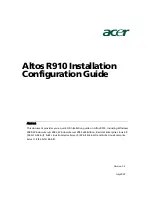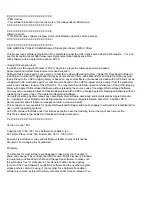
7 • Dial In
Access Server Administrators’ Reference Guide
72
Dial In Modify window
Modify Login
This portion of the Dial In Modify window (see figure 21 on page 71) describes configuring the IP address
pool, login technique and general login information.
IP Address Pool (diIpPool)
The IP address pool contains the IP addresses that are assigned dynamically to the dial-in connections. Type the
IP address pool in the space provided. The IP addresses can be noncontiguous addresses configured as follows:
– Blocks of IP addresses are designated with a dash (-) separating the first and last host in the block (for
example, 209.49.110.151-155)
– You can create a range of several individual addresses by using commas (,) (for example,
209.49.110.3,10,13)
– The addresses can be from a subnet other than the local network the RAS is on
– The IP address pool can have IP addresses from multiple subnets (for example, 192.155.155.1-6;
192.155.160.41-46)
Note
The IP address pool is limited to 39 characters.
Login Technique (diLoginTechnique)
This variable defines the login sequence that a dial-up user will see. The various options are defined below:
•
none(0)—no login sequence is enabled
•
textORpap(1)—This setting enables clear text logins or PPP calls using PAP authentication.
•
text(2)—A username prompt is displayed and a username must be entered. If the received username is a
static user with no password defined, then the connection completes and no password prompt is issued. If a
password is required then a password prompt is displayed and a password must be entered.
•
pap(3)—This setting assumes that all calls will be PPP users. No username or password prompt will be dis-
played. The system will go directly to PPP processing. The dial-up user must be configured for PAP authen-
tication.
Note
If the user trying to connect to the access server is not configured for
PAP he will be disconnected.
•
chap(4)—This setting assumes that all calls will be PPP users. No username or password prompt will be dis-
played. The system will go directly to PPP processing. The dial-up user must be configured on his computer
for CHAP authentication.
Note
If the user trying to connect to the access server is not configured for
CHAP he will be disconnected.
•
chapORpap(5)—This setting assumes that all calls will be PPP users. No username or password prompt
will be displayed. The system will go directly to PPP processing. The dial-up user must be configured for
PAP or CHAP authentication. The access server will always request CHAP authentication first. Therefore,
if a user can negotiate either CHAP or PAP, CHAP authentication will be performed.
Summary of Contents for Access Server
Page 24: ...Contents Access Server Administrators Reference Guide 24 ...
Page 28: ...About this guide Model 2960 RAS Getting Started Guide 28 ...
Page 58: ...5 Authentication Access Server Administrators Reference Guide 58 Static User Authentication ...
Page 94: ...7 Dial In Access Server Administrators Reference Guide 94 Dial In User Statistics window ...
Page 110: ...8 Dial Out Access Server Administrators Reference Guide 110 Dial Out User Statistics window ...
Page 134: ...12 Filter IP Access Server Administrators Reference Guide 134 Defining a filter ...
Page 174: ...17 MFR Version 2 Access Server Administrators Reference Guide 174 ...
Page 184: ...17 MFR Version 2 Access Server Administrators Reference Guide 184 MFR Version 2 Modify ...
Page 190: ...18 RIP Version 2 Access Server Administrators Reference Guide 190 RIP Version 2 Statistics ...
Page 196: ...19 SNMP Access Server Administrators Reference Guide 196 Out ...
Page 248: ...23 TCP Access Server Administrators Reference Guide 248 TCP Details ...
Page 252: ...24 UDP Access Server Administrators Reference Guide 252 Introduction ...
Page 258: ...26 License Access Server Administrators Reference Guide 258 End User License Agreement ...
















































